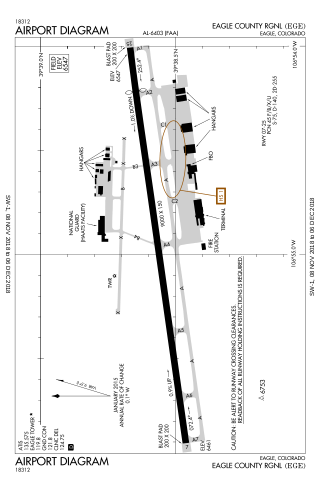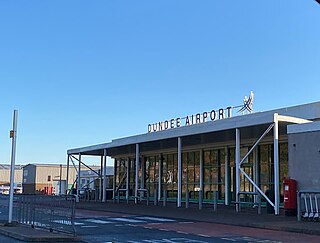
An airline is a company that provides air transport services for traveling passengers and/or freight. Airlines use aircraft to supply these services and may form partnerships or alliances with other airlines for codeshare agreements, in which they both offer and operate the same flight. Generally, airline companies are recognized with an air operating certificate or license issued by a governmental aviation body. Airlines may be scheduled or charter operators.

An airport is an aerodrome with extended facilities, mostly for commercial air transport. Airports usually consist of a landing area, which comprises an aerially accessible open space including at least one operationally active surface such as a runway for a plane to take off and to land or a helipad, and often includes adjacent utility buildings such as control towers, hangars and terminals, to maintain and monitor aircraft. Larger airports may have airport aprons, taxiway bridges, air traffic control centres, passenger facilities such as restaurants and lounges, and emergency services. In some countries, the US in particular, airports also typically have one or more fixed-base operators, serving general aviation.

Sandefjord Airport, Torp is a minor international airport located 4 nautical miles northeast of Sandefjord and 110 kilometers (68 mi) south of Oslo in Norway. The airport features a 2,989-meter (9,806 ft) runway aligned 18/36. Torp partially serves as a regional airport for Vestfold and in part as a low-cost airport for Eastern Norway and the capital, Oslo. Widerøe have a base at Torp, serving both domestic and shorter International flights. It also sees scheduled flights by airBaltic, Ryanair, Wizz Air, and Norwegian Air Shuttle. As of 2021, it is the second-largest airport in eastern Norway in terms of flights after Rygge shut down in 2016.
Widerøes Flyveselskap AS, trading as Widerøe, is a Norwegian airline, and is the largest regional airline operating in the Nordic countries. The airline's fleet of 44 Bombardier Dash 8 aircraft, with three more on order, and 3 Embraer E190-E2 aircraft, serves over 40 domestic and international destinations. Widerøe has a turnover of 3.5 billion kr; carries 2.8 million annual passengers; has 3,500 employees and performs 450 take-offs and landings each day. Public service obligation services to regional airports make up slightly less than half of Widerøe's operations. The remaining services are to primary airports in Northern Norway, and services from Sandefjord Airport, Torp and Bergen Airport, Flesland to other primary airports, and some international services from Oslo/Gardermoen, Sandefjord/Torp, Kristiansand/Kjevik, Stavanger/Sola, Bergen/Flesland and Trondheim/Værnes.

Eagle County Regional Airport is in Gypsum, Colorado, United States, 4 miles from Eagle and 37 miles from Vail. It covers 632 acres (256 ha) and has one runway. The History Channel rated Eagle County Regional Airport as #8 on its list of Most Extreme Airports in July 2010 due to the elevation, weather, approach through mountainous terrain and challenging departure procedures. In 2008–09 the airport completed a runway repaving and extension project, increasing the runway length to 9,000 feet.

London Southend Airport is a minor international airport situated on the outskirts of Southend-on-Sea in Essex, England, approximately 36 miles (58 km) from the centre of London. The airport straddles the boundaries between the city of Southend-on-Sea and the Rochford District.

Sultan Abdul Aziz Shah Airport, , often called Subang Airport or Subang Skypark, is an airport located in Subang, Petaling District, Selangor, Malaysia.

Patrick Leahy Burlington International Airport is a joint-use civil-military airport serving Burlington, Vermont's most populous city, and its metropolitan area. Owned by the City of Burlington, the airport itself is located in neighboring South Burlington, just three nautical miles (6 km) east of Burlington's central business district.

Dundee Airport is an airport based in Dundee, Scotland. It lies on the shore of the Firth of Tay and overlooks the Tay Rail Bridge.
ExpressJet Airlines was a regional airline in the United States that operated from 1987 until 2022. It was headquartered in College Park, Georgia. The company began as Britt Airways and flew exclusively as Continental Express, the contracted codeshare partner for Continental Airlines. The name was changed to ExpressJet at the beginning of 1995 as the company began acquiring Regional jets, replacing its fleet of turboprop aircraft. Along with flying as Continental Express, ExpressJet expanded flying under the Delta Connection brand from 2007 through 2008 and again from 2012 through 2018. Service as American Eagle was flown between 2012 and 2019 and service under the United Express brand began in 2009. ExpressJet also flew an independent operation under their own brand in 2007 through 2008. When Continental Airlines merged into United Airlines in 2012, the Continental Express operations were added to the United Express service. In September 2020, it exited the fee-for-departure airline market and temporarily ceased flights after the conclusion of its contract with its sole remaining mainline partner, United Airlines. In September 2021, ExpressJet resumed operations as both an air charter provider and a regional airline under its own brand aha!—short for "Air-Hotel-Adventure." The brand's route structure focused on the West Coast of the United States with a hub at Reno-Tahoe International Airport, and scheduled flights began on October 24, 2021. The airline, including its brand aha!, filed for bankruptcy on August 23, 2022, having ceased all operations the previous day. In July 2023, the airline announced plans to relaunch as an air charter service using a single leased Boeing 777.

A passenger is a person who travels in a vehicle, but does not bear any responsibility for the tasks required for that vehicle to arrive at its destination or otherwise operate the vehicle, and is not a steward. The vehicles may be bicycles, buses, passenger trains, airliners, ships, ferryboats, and other methods of transportation.

Hydrocarbon Oil Duty is a fuel tax levied on some fuels used by most road motor vehicles in the United Kingdom; with exceptions for local bus services, some farm and construction vehicles and aviation, which pay reduced or no fuel duty.
Fractional ownership of aircraft is an arrangement in which multiple owners share the use and costs of purchasing and operating an aircraft. Several management companies provide fractional ownership programs for aircraft, including NetJets, Flexjet, Volato, PlaneSense, and AirSprint. Alternatively, owners can join together to purchase their aircraft, independently of any management company.
Deadheading can refer to the following:

A transport hub is a place where passengers and cargo are exchanged between vehicles and/or between transport modes. Public transport hubs include railway stations, rapid transit stations, bus stops, tram stops, airports and ferry slips. Freight hubs include classification yards, airports, seaports and truck terminals, or combinations of these. For private transport by car, the parking lot functions as a unimodal hub.

Geraldton Airport is an airport located 6 nautical miles east of Geraldton, Western Australia, in Moonyoonooka along the Geraldton – Mount Magnet Road.
VistaJet is a global business aviation company founded in 2004 by Thomas Flohr. The firm flies between any two points, under a "pay for hours flown" fare structure.

Tillingbourne Bus Company was a bus company based in Cranleigh, Surrey. The company operated bus and coach services in Surrey, West Sussex, Hampshire and Berkshire from 1924 until 2001.
Deadheading is the practice of carrying, free of charge, a transport company's own staff on a normal passenger trip so that they can be in the right place to begin their duties. In United States railway usage, the term may also be used for movement of train crews to or from a train using another means of vehicular transportation, as passenger train service is infrequent or nonexistent in many areas.
LunaJets is a private jet broker with headquarters in Geneva, Switzerland, where it has been based since it was founded in 2007 by former Ogilvy advertiser Eymeric Segard. Additionally, they have opened offices throughout the years in London, Paris, Monaco, Riga and Dubai.













